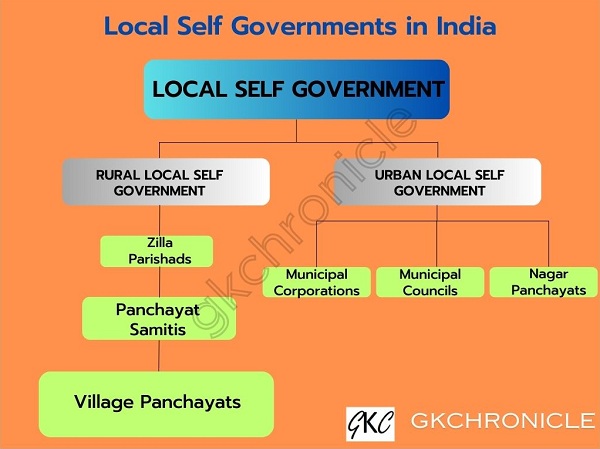Indian Polity / Local Self Governments
Salient Features of Local Self Government
Article 40 incorporated in the Directive Principles of State Policy
deals with establishment of Panchayati Raj institutions. In order to give power to the rural and urban population to participate in their
development wellbeing, local self governments were established. The purpose of local self governments is for democratic decentralization.
Evolution of Local Self Government in India
- The evolution of local self government in India got started when the Central Government introduced Community Development Programme in 1952.
It is the first developmental programme in India. In 1953, the Central Government introduced another programme named National Extension Programme (NEP).
- In 1957, Government constituted a study team under the chairmanship of Balwant Rai Mehta. This was appointed to take stock of the working of
Community Development Programme and National Extension Programme. Its report was submitted in 1958.
The Balwant Rai Mehta Committee recommended 3-tier Panchayati Raj Institutions, which facilitates the people's participation. Accordingly, 3-tier system was introduced in some
states. The first state to introduce 3-tier Panchayati Raj System was Rajasthan in 1959.
- In 1977, Janata Government appointed one more Committee under the chairmanship of Ashok Mehta. It examined and reported in 1978 regarding the
working of 3-tier system. This report could not be implemented because of political problems.
Ashok Mehta Committee recommended 2-tier system. It recommended for abolition of Gram Panchayat due to lot of politicization. It
also recommended for strengthening of Mandal Panchayat System. Its recommendations were not given effect due to fall of Janata Government.
- In 1985, Planning Commission constituted G.V.K. Rao Committee on Administrative Arrangement for Rural Development and Poverty Alleviation
Programmes. Its recommendations could not be implemented.
It called for de-bureaucratization of rural development and increase the role
for elected representatives in rural development.
- In 1986, L.M. Singhvi Committee was appointed to revitalize the Panchayati Raj Institutions. He recommended for according Constitutional status
to Local Self Governments.
As a result, 64th Amendment Bill was introduced in 1989. It was approved by Lok Sabha but rejected by
Rajya Sabha. Hence, the Bill was defeated.

- In 1992, when Mr. P.V. Narasimha Rao was the Prime minister, 73rd and 74th Constitutional Amendments were approved and became Acts in 1993
and they came into force from 1993 onwards. Rural Local Bodies came into force
from 24th April, 1993 and Urban Local Bodies came into force from
1st June, 1993.
3-tier system at rural areas are, at village level - Gram Panchayats, at intermediate level - Block Panchayats or Mandal Parishads or Panchayat Samitis and at District level - Zilla Parishads or Zilla Panchayats.
3-tier system at urban areas include 1st tier - Nagar Panchayats, 2nd tier - Municipal Councils and 3rd tier - Municipal Corporations.
- There are no Panchayati Raj Institutions in the states of Nagaland, Meghalaya and Mizoram.
Important Features of Local Self Governments
- One of the important features of local government is that a 3-tier system is to be there both at rural and urban levels. However,
the 3-tier system is not applicable to the States having less than 20 lakh population.
- The minimum age to contest elections at all levels is 21 years.
- Reservations are provided to SCs and STs according to their population. Reservations are also extended to women. 33.33% of seats are reserved for
women in all levels of Local Self Governments. Reservations can be provided to Backward Castes if a State decides so.
- All representatives of local bodies are elected directly. However, the President of Gram Panchayat is elected by the procedure fixed by the State.
The elections are not political elections.
In intermediate and district levels, the heads are elected indirectly. However, the heads of Urban
Local Governments are elected according to the procedure fixed by the State Government.
- The Governor of the state appoints the State Election Commissioner, who conducts election for local bodies. He is appointed for
the term of 5 years. He is removed like that of judges of the High Court. That is, the President removes him on passage of a
resolution by the Parliament.
- Elections could be conducted for all the levels of Local Governments for every 5 years. But, internal adjustments can be made by State Legislatures
and also they can fix other qualifications and conditions for local bodies.
- Elections are to be conducted within 6 months after vacation of a seat.
Quiz
- Which Committee recommended for according Constitutional status to the Local Self Governments?
- L.M. Singhvi Committee
- G.V.K. Rao Committee
- Balwant Rai Mehta Committee
- Ashok Mehta Committee
Answer
Ans: A
- What is the minimum age required to contest the Local Body elections at all levels?
- 25
- 35
- 21
- 30
Answer
Ans: C
- Which of the following states adopted Panchayati Raj system for the first time in 1959?
- Andhra Pradesh
- Kerala
- Odisha
- Rajasthan
Answer
Ans: D
- There are no Panchayati Raj Institutions in which one of the following states?
- Andhra Pradesh
- Tripura
- Nagaland
- Tamil Nadu
Answer
Ans: C



